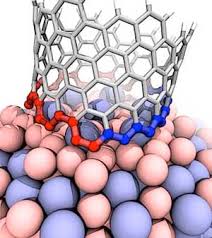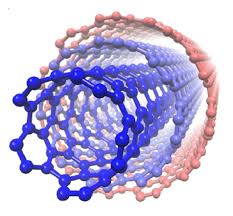Isolation of SWCNTs by Covalent Methods and Wall Functionalization (Nanoscience Ph.D
Researcher and author: PhD student Afshin Rashid)
Note: Isolation of SWCNTs by covalent methods of functionalizing the wall of carbon nanotubes is a cylindrical structure of SP2. And the carbon atoms hybridization associated with the inactivity of the carbon nanotube precisely adapts to the orbital π curvature.
The higher activity of carbon nanotubes with smaller diameters than enhancement reactions could be due to the increase in space pressure. In addition, electrophilic enhancement selectivity reactions on SWCNTs are much easier for metal nanotubes because their HOMO levels are higher. Selectivity in wall functionalization reactions , based on DOS, can be understood to play an important role in the functionalization of the wall of carbon nanotubes. Metal nanotubes, unlike semiconductor SWCNTs, have DOS electrons at the Fermi surface and the Fermi surface has the chemical potential of the electrons. At zero, this surface contains electrons, but in the semiconductor the electrons fall into the energy gap, where there are no permissible energy levels. Therefore, electrons exist to stabilize the charge transfer complex formed by increasing the reactant to the nanotube surface. Metal SWCNTs are better able to withstand the modifier and therefore the reaction rate is increased. This may be due to the activity of metal SWCNTs in electrophilic augmentation reactions such as increased dichlorocarbon and reactive carbon (iodinated azonium) and increased hydrosilytation . As for the reactions of SWCNTs with diazonium ions or salts, so far, for the first time, water-soluble aryl diazonium reactants selectively exhibit good activity with metal SWCNTs .
Diazonium salts form metal semiconductor SWCNTs by forming aryl covalent bonds on nanotube . After heat treatment of nanotubes with azonium groups, metal nanotubes are recovered and the aryl groups are separated from the nanotube walls. The presence of diazonium functional group inactivates metal nanotubes in electrical equipment because the diazonium covalent functionalization significantly disturbs the optical and electrical properties of metal SWCNTs. To optimize this reaction, more benzene salt research is being carried out.
Conclusion:
Selective covalent functionalization of semiconductor SWCNTs walls due to the dipole reaction of cyclic enhancement of azomethineylides derived from triacyl-N-oxides with polycyclic aromatics increases the amount of metal nanotubes in bottom sediment . Theoretical studies show that dipole ring enhancement is sensitive to the diameter and chirality of nanotubes.
Author: Engineer Afshin Rashid
PhD student of Nano-Microelectronics at Islamic Azad University, Science and Research Branch, Tehran




